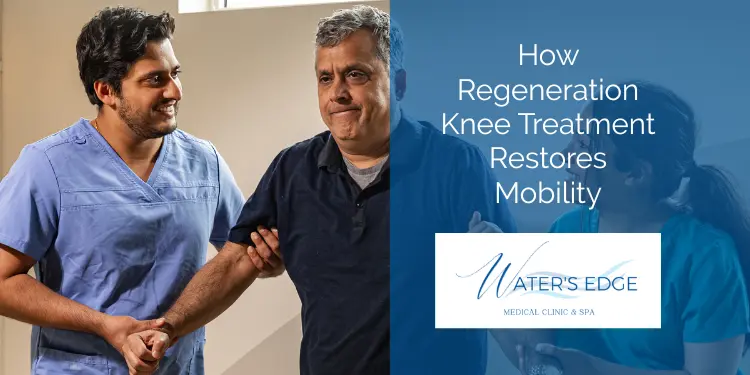When your knees hurt, even basic tasks like walking or climbing stairs become difficult. For a long time, options were limited, often leading straight to surgery. But now, there’s a different approach gaining traction: regeneration knee treatment. This method taps into your body’s own healing power to fix damaged knee tissues. It’s a way to potentially avoid surgery and get you moving more freely again. Let’s explore what this kind of treatment involves and who might benefit.
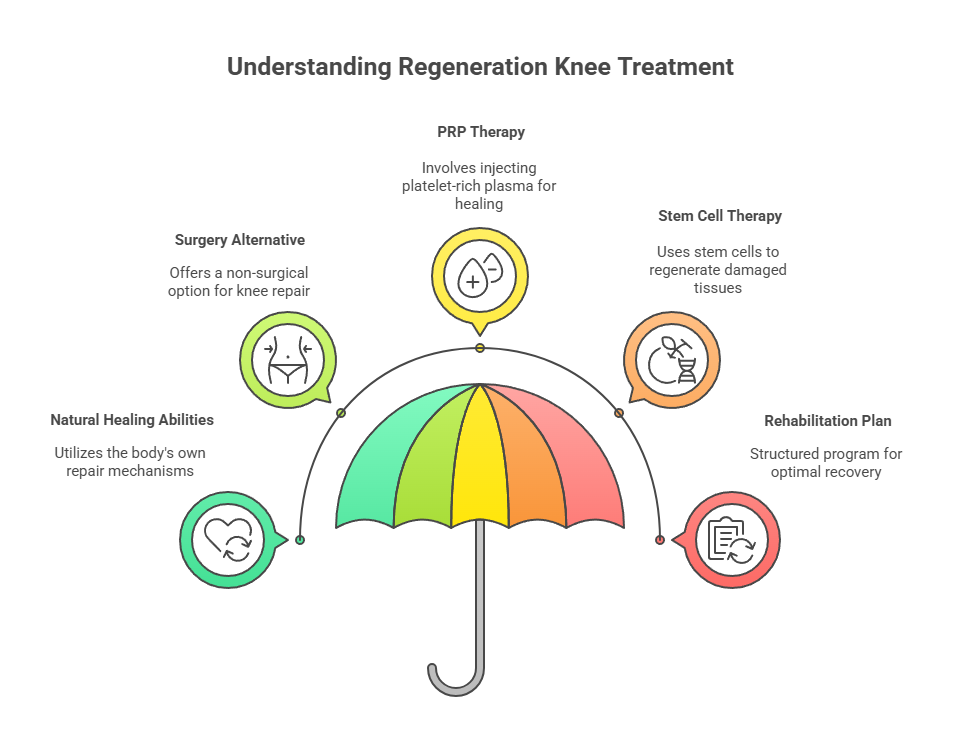
Key Takeaways
- Regeneration knee treatment uses your body’s natural healing abilities to repair damaged knee tissues, offering an alternative to surgery.
- May help you postpone or even avoid joint replacement surgery altogether.
- While treatments like PRP and stem cell therapy are promising, outcomes can vary, and a structured rehabilitation plan is often recommended for best results.
What Is Regeneration Knee Treatment and How Does It Work?
Regeneration knee treatment is a modern approach to addressing knee pain and dysfunction, moving beyond just managing symptoms to actually helping the knee heal itself. Instead of just masking the pain, these therapies aim to repair damaged tissues, like cartilage, and restore the knee’s natural function. It’s a pretty big shift from older methods that often just focused on pain relief without fixing the underlying problem.
Key Components of Regeneration Knee Treatment
These treatments often involve using your body’s own healing power. Think of it like giving your knee a supercharged boost to repair itself. Here’s a look at some common elements:
- Platelet-Rich Plasma (PRP): This involves drawing your blood, concentrating the platelets (which are packed with growth factors), and injecting them back into your knee. These growth factors can signal your body to start healing and rebuilding tissue.
- Stem Cell Therapy: This treatment uses stem cells—often derived from Wharton’s jelly in donate. The idea is to introduce these cells to the damaged area to help regenerate new tissue. Many people look for knee regeneration therapy reviews to understand the outcomes of these treatments.
- Exosomes: These are tiny vesicles released by cells, including stem cells, that carry important signaling molecules. They can communicate with other cells to promote healing and reduce inflammation.
- Hyaluronic Acid: Often used to improve joint lubrication and cushioning, it can help make movement smoother and reduce friction.
- Ozone Therapy: Medical ozone therapy helps reduce inflammation and supports the body’s natural healing processes within the joint.
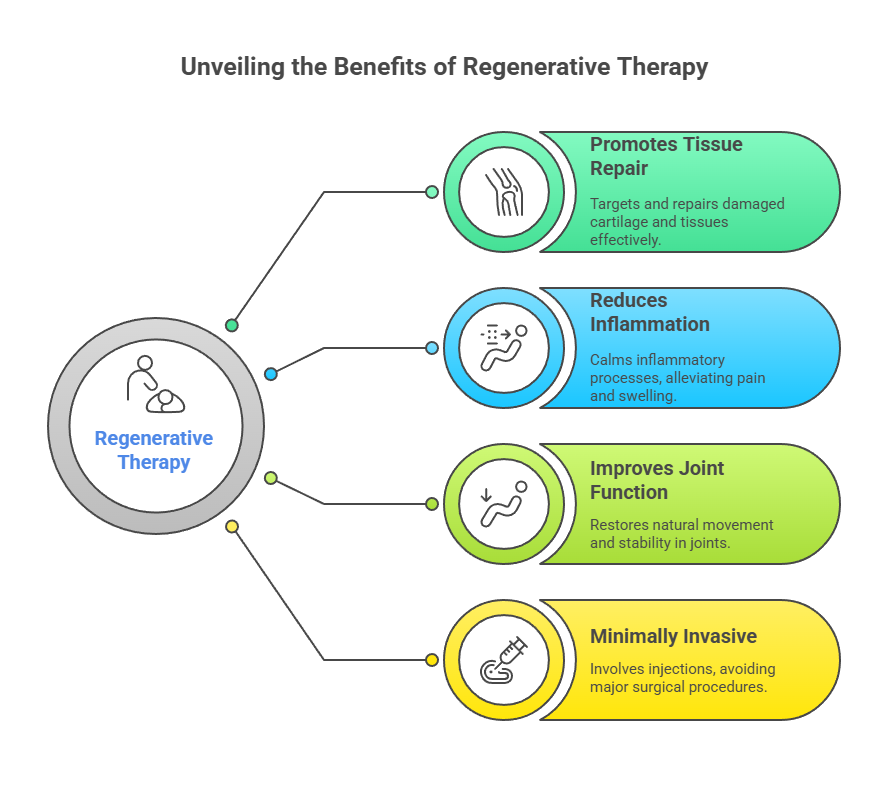
How the Process Works
Every case is different, but it usually starts with a detailed exam to see how much damage the knee has. This might include imaging like MRIs. Then, a treatment plan is developed, which could involve one or a combination of the regenerative methods mentioned above. The injections are typically done in a clinic setting. The goal is to create an environment where the knee can heal and rebuild itself, leading to improved mobility and reduced pain.
Benefits of Regenerative Approaches
- Promotes Tissue Repair: Directly targets damaged cartilage and other tissues.
- Reduces Inflammation: Helps calm down the inflammatory processes that contribute to pain.
- Improves Joint Function: Aims to restore natural movement and stability.
- Minimally Invasive: Often involves injections rather than major surgery.
While these treatments are promising, it’s important to remember that results can vary. The effectiveness often depends on the individual’s condition and how their body responds to the therapy. It’s a good idea to discuss your specific situation with a qualified healthcare provider to see if it’s the right option for you. You can explore stem cell therapy for knee cartilage regeneration to learn more about one specific approach.
Who Can Benefit from Regeneration Knee Treatment?
Regenerative knee treatments are becoming a popular choice for many people experiencing knee pain and mobility issues. If you’re looking for alternatives to traditional surgery or seeking to improve your knee’s function, this might be for you. It’s not a one-size-fits-all solution, but a good number of individuals can find relief and better movement through these advanced therapies.
Specific Conditions and Patient Types
Several types of knee problems can potentially be addressed with regenerative treatments. These often include:
- Osteoarthritis: This is a common condition where the cartilage in the knee joint wears down over time. Regenerative therapies aim to stimulate the body’s natural healing processes to repair or regenerate this damaged cartilage, offering relief from pain and stiffness. Many people with mild to moderate osteoarthritis find these treatments beneficial.
- Cartilage Damage: Knee injuries or gradual wear and tear can result in localized cartilage damage within the joint. Treatments can help repair these defects, improving the joint’s smooth operation and reducing pain.
- Ligament and Meniscus Tears: While not always the primary focus, some regenerative approaches can support the healing of soft tissue injuries, including certain types of ligament or meniscus damage, especially when combined with other therapies.
- Post-Surgical Recovery: For some individuals, regenerative treatments might be used to aid recovery after surgery, potentially speeding up healing and improving long-term outcomes.
When Traditional Methods Aren’t Enough
Many people turn to regenerative medicine when conventional treatments haven’t provided the desired results. This could include:
- Individuals who have tried physical therapy, pain medications, or injections without significant or lasting improvement.
- Those who wish to avoid or delay invasive surgical procedures like knee replacement, especially if they are younger or have specific health considerations.
- Ideal for individuals seeking a natural healing approach that supports the body’s own repair mechanisms.
Factors to Consider
It’s important to remember that the success of regenerative knee treatment can depend on several factors, including the specific condition, its severity, and the individual’s overall health. A comprehensive evaluation by a qualified healthcare. They will evaluate your knee, review your medical history, and outline the potential benefits and limitations of the treatment based on your individual needs. Finding the right clinic is key; for example, Waters Edge Medical Clinic and SPA in St. Petersburg, FL offers various natural and regenerative medicine options for pain relief.
The goal of regenerative knee treatment is to harness the body’s inherent ability to heal. By introducing specific biological agents or stimulating natural repair pathways, these therapies aim to restore joint function and alleviate pain, offering a path toward improved mobility and a better quality of life for many.
Regeneration Knee Treatment vs. Traditional Options
When you’re dealing with knee pain, it’s natural to look at all the options available. Traditional treatments have been around for a while, and they often focus on managing symptoms rather than fixing the underlying problem. Think of things like pain medications, cortisone shots, or even physical therapy aimed at strengthening muscles around the knee. These can offer some relief, but they don’t typically encourage your body to actually repair itself.
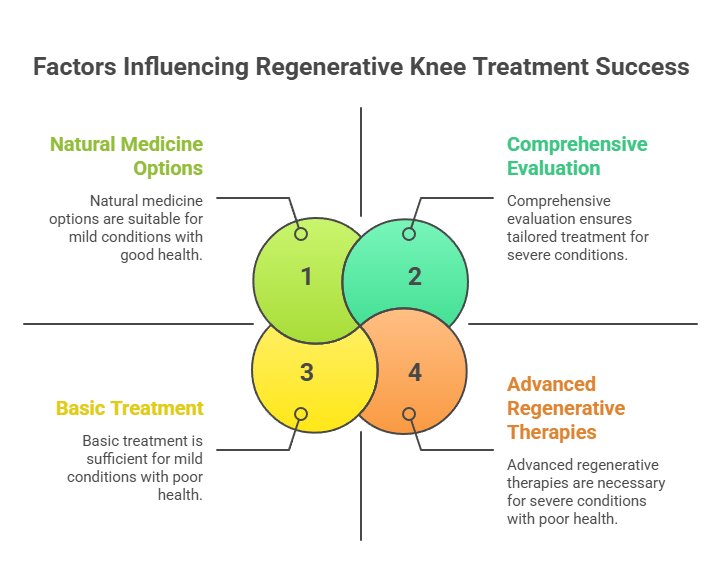
Regenerative treatments, on the other hand, are a bit different. They aim to use your body’s own healing power to repair damaged tissues. This might involve things like platelet-rich plasma (PRP) or stem cell therapy. The idea is to kickstart a natural healing process, potentially leading to more lasting results.
Symptom Management vs. Tissue Repair
Traditional methods often concentrate on masking pain and reducing inflammation. This can be helpful in the short term, but it doesn’t address the root cause of the knee issue, like worn-out cartilage or damaged ligaments. Regenerative approaches try to get to the heart of the matter by stimulating the body to rebuild or repair the damaged parts of the knee. It’s a shift from just feeling better to actually getting better.
Invasive vs. Minimally Invasive Procedures
Many traditional treatments, especially if the condition progresses, might eventually lead to surgery. While surgery can be effective, it’s also more invasive. Regenerative treatments are often designed to be minimally invasive, meaning they typically involve injections rather than major surgery. This can mean less downtime and a quicker recovery for many patients.
Long-Term Outlook and Joint Health
One of the big differences lies in the long-term goals. Traditional treatments might help you manage your knee pain for years, but they don’t usually reverse the degenerative process. Regenerative medicine focuses on restoring the joint’s natural function and may help delay—or even prevent—the need for joint replacement surgery. It’s about preserving your natural joint for as long as possible. For those looking into these advanced options, understanding the 12-week regenerative journey can provide a clearer picture of what to expect.
Potential for Avoiding Surgery
For many people, the ultimate goal is to avoid invasive surgery. Regenerative therapies offer a promising avenue for this. By supporting cartilage repair and enhancing overall knee joint health, these treatments can restore mobility and function without the risks of traditional surgery. This can mean getting back to daily activities sooner and with less disruption.
Understanding Regenerative Knee Treatment Cost
When considering regenerative knee treatment, understanding the associated costs is a significant part of the decision-making process. Unlike many traditional medical procedures, regenerative therapies often fall outside standard insurance coverage, which can make the upfront investment seem higher. This is partly because regenerative medicine is a newer field, and its treatments are sometimes viewed as experimental. Therefore, patients should be prepared for out-of-pocket expenses.
Factors Influencing Regenerative Knee Treatment Cost
The specific regenerative knee treatment cost can vary widely based on several factors. These include the type of regenerative therapy used (e.g., platelet-rich plasma (PRP), stem cell therapy, or other orthobiologics), the number of treatment sessions required, and the specific clinic or provider you choose. Some treatments might involve a single injection, while others may require a series of procedures to achieve optimal results. The severity of your condition also matters—more advanced joint degeneration may require more intensive or specialized treatment options.
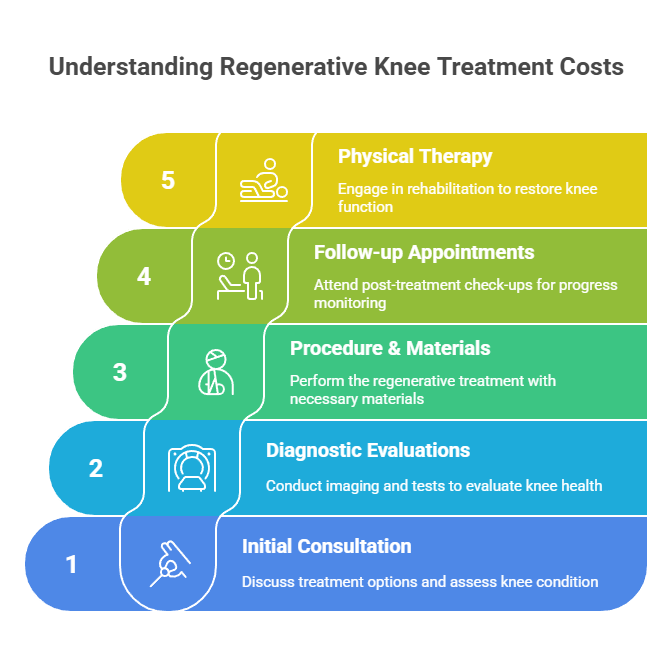
What’s Typically Included in the Cost
Generally, the regenerative knee treatment cost covers the procedure itself, including the preparation and administration of the regenerative materials. It often includes the initial consultation and diagnostic evaluations, such as imaging (like MRIs), to assess the knee’s condition thoroughly. Post-treatment follow-up appointments and any necessary physical therapy or rehabilitation protocols are sometims bundled into the overall price. It’s important to clarify with your provider exactly what is included to avoid unexpected charges.
Comparing Costs with Traditional Options
While regenerative knee treatment cost might seem substantial initially, it’s beneficial to compare it with the long-term expenses of traditional treatments. Options like repeated pain injections, physical therapy over many years, or surgical interventions (like knee replacement) can also accumulate significant costs, not to mention the extended recovery times and potential for complications. Regenerative medicine focuses on treating the underlying cause of knee pain, not just masking the symptoms, potentially offering a more sustainable solution that could reduce the need for ongoing treatments or more invasive procedures down the line. This approach focuses on promoting the body’s natural healing capabilities.
Financial Planning for Regenerative Knee Treatment
Given that insurance coverage for regenerative medicine for knee pain can be limited, financial planning is key. Many clinics offer payment plans or financing options to make these treatments more accessible. It’s advisable to discuss these possibilities openly with the provider’s administrative staff. Understanding the total knee regeneration therapy cost upfront and exploring all available payment avenues will help you make an informed decision about proceeding with treatment.
How to Find the Best Regeneration Knee Treatment Near Me
When you’re looking for regenerative knee treatment near me, it’s important to do your homework. Not all clinics or doctors offer the same level of care or have the same experience with these advanced therapies. You want to find someone who really understands how to help your knee get better. Think about it like this: you wouldn’t go to a general mechanic to fix a specialized piece of equipment, right? The same applies here.
Researching Potential Providers
Start by looking into orthopedic specialists or regenerative medicine clinics in your area. Check their websites for information about the specific treatments they offer, like platelet-rich plasma (PRP) or stem cell therapy. See if they detail their approach to knee conditions and if they have patient testimonials or case studies available. This can give you a good sense of their focus and success rates.
Checking Credentials and Experience
It’s a good idea to verify the qualifications of the medical professionals. Are they board-certified in orthopedics or a related field? How long have they been performing regenerative knee treatments? Some providers might have specialized training or fellowships in regenerative medicine. Don’t hesitate to ask about their experience with your specific knee issue, whether it’s osteoarthritis, a cartilage defect, or an injury.
Understanding Treatment Approaches
Regenerative medicine for knees isn’t a one-size-fits-all solution. Different providers might use slightly different protocols or combinations of therapies. Some may focus on injections like hyaluronic acid combined with other regenerative agents, while others might incorporate minimally invasive procedures. Understanding their specific approach can help you determine if it aligns with your expectations and what you’ve learned about your condition.
Consulting with Specialists
AGot a few clinics in mind? The next step is to book consultations and see which one feels right for you. This is your chance to ask questions and get a feel for the clinic’s environment and the doctor’s communication style. A good doctor will take the time to explain the potential benefits, risks, and expected outcomes of the treatment for your individual case. They should also discuss the recovery process and what you can expect afterward.
Considering Patient Reviews and Outcomes
Look for patient reviews online, but read them critically. Focus on comments that discuss the effectiveness of the treatment, the doctor’s bedside manner, and the overall patient experience. While individual results can vary, consistent positive feedback about pain relief and improved mobility can be a strong indicator of a reputable provider.
Selecting the right specialist plays a critical role in your recovery and overall knee health. Ask questions, trust your gut, and take your time selecting the right provider for regenerative knee care.
Moving Forward with Regenerative Knee Treatment
So, it looks like regenerative medicine is really changing the game for knee pain. Instead of just masking symptoms, these treatments aim to get to the root of the problem, helping your body heal itself. Whether it’s through therapies like PRP, stem cells, or other advanced methods, the goal is to get you moving better and feeling less pain, often without needing surgery. It’s about giving your knee a chance to repair and recover, so you can get back to doing the things you enjoy. While it’s not a magic fix for everyone, the progress being made offers a lot of hope for people dealing with knee issues.

Frequently Asked Questions

What exactly is regenerative knee treatment?
Regenerative knee treatment uses your body’s own natural healing power to fix damaged knee tissues. Therapies like platelet-rich plasma (PRP) and stem cell treatments inject special parts from your blood or cells into the knee. These parts help reduce swelling and encourage the body to repair itself, offering a way to heal without surgery.
Who typically benefits from this type of treatment?
Many people can benefit from regenerative knee treatments. This includes individuals with knee pain from conditions like arthritis, old injuries, or general wear and tear. It’s a good option for those who want to avoid surgery or find relief when other treatments haven’t worked.
How does regenerative treatment compare to surgery or other common knee pain solutions?
Regenerative treatments are often less invasive than traditional surgery. This means less downtime and a quicker return to daily activities. Unlike some older methods that just manage pain, regenerative medicine aims to actually repair the damaged knee tissue, potentially leading to longer-lasting results.
If you have any additional questions or if you would like to see if regenerative medicine is right for you, please contact us at Waters Edge Medical Clinic 727-550-0855 and receive a free consultation and evaluation.

